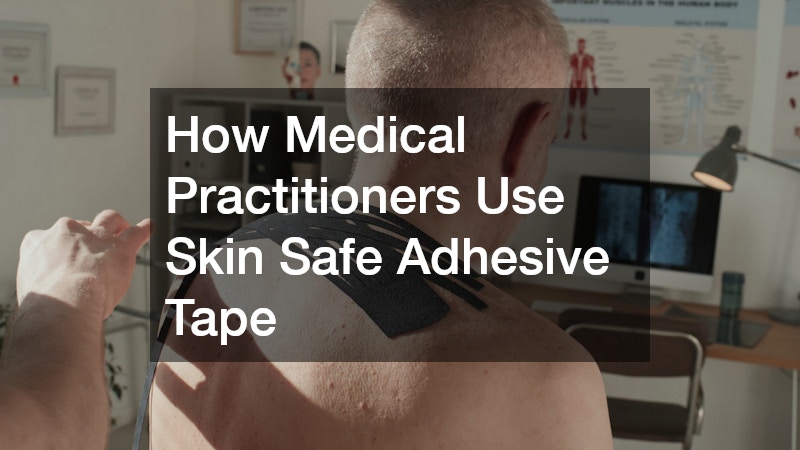
Skin safe adhesive tape is an indispensable tool in medical settings, providing secure and gentle adhesion for various medical purposes. Its importance cannot be overstated, as it ensures both efficacy and patient comfort across a wide range of applications.
The versatility of skin safe adhesive tape makes it a staple in medical practice, from securing dressings to supporting healing processes. Medical practitioners rely on these tapes for their reliability and their ability to minimize skin reactions.
Understanding the different types of skin safe adhesive tapes and their applications is crucial for optimizing patient care and outcomes. This article delves into the various types, uses, and important considerations for these medical tapes.
1. What are the Different Types of Skin Safe Adhesive Tape?
1.1. Paper Tape
Paper tape is one of the most commonly used forms of skin safe adhesive tape in hospitals and clinics. It is lightweight, breathable, and especially suitable for sensitive skin due to its gentle adhesive.
This type of tape is preferred for use where frequent tape changes are necessary to reduce irritation. Its easy tear capability also makes it convenient for rapid application in fast-paced environments.
Medical practitioners often choose paper tape for securing dressings that require observation since it allows the skin to breathe. Furthermore, its hypoallergenic properties reduce the risk of allergic reactions.
1.2. Cloth and Silk Tape
Cloth and silk tapes are known for their strength and durability, making them suitable for securing heavier bandages or medical tubing. Despite their robust adhesive properties, they remain gentle on the skin.
These tapes are designed to withstand greater stresses without compromising on patient comfort. This makes them ideal for long-term applications where tape needs to remain in place under different conditions.
The flexibility of cloth and silk tapes allows them to conform to body contours, ensuring secure attachment even in challenging areas. They are favored by practitioners for their balance of strength and skin safety.
2. How is Skin Safe Adhesive Tape Used in Wound Care?
2.1. Securing Bandages
One of the primary roles of skin safe adhesive tape in wound care is securing bandages. Its strong yet gentle adhesion ensures that bandages remain in place, allowing for effective protection of the wound site.
Medical practitioners rely on these tapes to maintain a sterile environment, reducing the risk of contamination. They can confidently secure dressings without fear of skin damage upon removal.
By keeping bandages securely in place, adhesive tapes help maintain proper moisture levels vital for wound healing. This stability facilitates the natural recovery process while minimizing disturbance from external factors.
2.2. Preventing Infections
Skin safe adhesive tape plays a critical role in preventing infections, a key concern in wound care. Its secure adhesion helps to create a barrier against environmental contaminants.
The integrity of bandages secured with adhesive tape ensures reduced exposure to harmful pathogens. Medical practitioners can thus focus on patient healing without the added concern of infection risks.
By safeguarding the wound area, adhesive tapes contribute significantly to infection control protocols. They are a vital component of comprehensive infection prevention strategies in healthcare settings.
3. What Considerations are Important for Patients with Sensitive Skin?
3.1. Hypoallergenic Options
For patients with sensitive skin, hypoallergenic adhesive tapes are a necessity to prevent irritation and allergic reactions. These specialized tapes are crafted to minimize the risk of adverse skin responses.
The gentle adhesives used in hypoallergenic tapes are carefully selected to provide adequate adhesion without compromising skin health. Medical practitioners prioritize these options to ensure patient comfort and safety.
Besides reducing irritation, hypoallergenic tapes are also breathable, reducing the risk of moisture accumulation and skin breakdown. This makes them ideal for patients with heightened skin sensitivity.
3.2. Proper Tape Removal Techniques
Proper removal techniques are crucial when dealing with adhesive tapes on sensitive skin to prevent trauma. Medical practitioners are trained to gently peel back tapes at an angle to minimize skin pulling.
Utilizing adhesive removers can aid in safe tape removal, especially for patients prone to skin tears. This step is essential in preserving the integrity of the skin upon tape removal.
Educating patients on proper tape removal can also contribute to their comfort and skin health. Ensuring that patients understand these techniques can increase adherence to wound care regimens.
4. How Do Medical Practitioners Ensure Adhesive Tape is Skin Safe?
4.1. Testing and Quality Control
To ensure skin safety, adhesive tapes undergo rigorous testing and quality control. Manufacturers test for various factors like adhesiveness, hypoallergenic properties, and durability.
These thorough testing processes help identify any potential allergens or irritants, ensuring only the safest products reach patients. Quality control measures are enforced to maintain consistent product safety.
Medical practitioners trust these tapes thanks to the stringent standards upheld during manufacturing. This ensures that all patients receive care with only the highest quality adhesive tapes.
4.2. Patient Feedback and Adaptations
Patient feedback is integral to the continuous improvement of adhesive tape products. Practitioners collect this information to identify areas needing adaptation for better skin compatibility.
Manufacturers use patient feedback to innovate and enhance product offerings, aligning with the needs of different patient demographics. This ongoing adaptation results in better, more comfortable adhesive solutions.
Engaging with patients in refining tape products helps ensure their comfort and adherence to treatment protocols. Continuous adaptation is a testament to the dynamic nature of healthcare product development.




